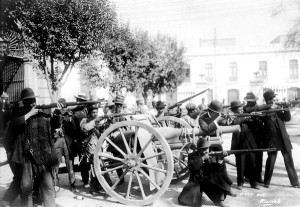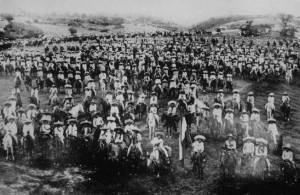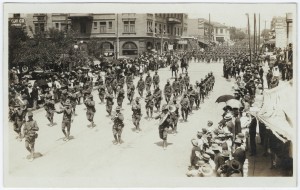- 624 163 5200 En Español
- 624 163 6700 En Español
- 480 422 6253 USA & Canada
- 480 275 8645 USA & Canada

The Mexican Revolution officially began in 1910 as a middle-class uprising against dictator Porfirio Diaz. Diaz assumed power of Mexico as a result of a military coup. Under his regime, the constitution was ignored and the politically powerful controlled the nation. After ousting Diaz from power, factions competed violently for power over the next 10 years.
1819: The Adams-Onis Treaty involved an agreement between the United States and Spain about the boundary between America and Mexico.
August 1821: The final Spanish viceroy signs the Treaty of Córdoba, setting in motion the beginning of Mexican independence.
1823: Iturbide is deposed by General Antonio López de Santa Anna, who officially declares a Mexican republic.
1833: Santa Anna becomes president of Mexico after leading the successful defense against Spain, which attempted to recapture Mexico.
May 12, 1846: The United States declares war on Mexico, beginning the Mexican-American War.
February 2, 1848: The Treaty of Guadalupe Hidalgo brought an end to the Mexican-American War.
1857: A new constitution is established, which creates a centralized form of government and guarantees freedom of speech and male suffrage.
1861: Benito Júarez becomes the Mexican president. Júarez cancels payments for Mexico’s debts to foreign governments.
June 1863: Napoleon III of France occupies Mexico City with troops, leading Júarez to flee the city.
1867: France finally withdraws its troops from Mexico under pressure from America.
1877: Díaz assumes control of Mexico, maintaining a dictatorship until 1911.
1884: Díaz begins a second term as Mexico’s president.
1908: Díaz announces his planned retirement at the end of his current term.
March 1908: Pearson’s Magazine publishes the “Creelman Interview.”
September 27, 1910: Diaz is named Mexican president for an eighth term.
October 11, 1910: Francisco Madero escapes from prison to Texas. Madero begins working toward a rebellion against Diaz.
November 19, 1910: During travel to Mexico, Madero encounters Mexican bandit Doroteo Arango, also known as Pancho Villa.
November 20, 1910: Madero begins to organize an uprising.
January 30, 1911: Pascual Orozoco attacks a federal garrison.
February 13, 1911: Jose Luis Moya takes occupation of Durango.
February 26, 1911: Moya captures Zacatecas.
March 6, 1911: Madero leads an attack on a federal garrison.
March 24, 1911: Emiliano Zapata organizes a revolutionary band to protest land lost by Indians.
April 3, 1911: Madero leads 500 revolutionaries in an attack against Ciudad Juarez.
May 7, 1911: Battles ensue throughout Mexico, and Diaz offers his resignation.
May 10, 1911: Federales occupying Ciudad Juarez surrender, which gives Madero and Villa access to modern weaponry.
May 13, 1911: Orzoco and Villa demand the execution of federal officers. With Madero’s refusal, Orzoco and Villa soon split from Madero.
May 21, 1911: Madero signs the Treaty of Ciudad with Diaz.
May 25, 1911: Riots break out in Mexico City. Diaz resigns, and Francisco Leon de la Barra becomes Mexico’s interim president.
June 1911: A powerful earthquake hits Mexico City, killing 207 people.
June 22, 1911: Pascual Orozoco’s army makes Chihuahua City its headquarters.
August 8, 1911: Victoriano Huerta arrives in Cuernavaca with about 1,000 troops to force the demobilization of Zapata and his army.
August 31, 1911: Huerta moves for Zapata’s arrest, but he runs away to the countryside.
November 6, 1911: Madero wins the Mexican presidential election, and he takes the oath of office.
March 3, 1912: Orozoco makes a move against Madero with an attack on a train full of federal soldiers.
April 26, 1912: Pedro Leon leads a mutiny in Mexico City.
February 9, 1913: Felix Diaz and generals Mondragon and Ruiz lead a 10-day mutiny against Madero.
February 22, 1913: Victoriano Huerta orders the murders of Madero and Vice President José María Pino Suárez. Huerta seizes power.
February 24, 1913: Venustiano Carranza leads a rebellion against Huerta.
 March 9, 1913: Villa escapes imprisonment and organizes an uprising against Huerta.
March 9, 1913: Villa escapes imprisonment and organizes an uprising against Huerta.
March 26, 1913: Carranza issues the Plan de Guadalupe, which officially refuses recognition of Huerta as president of Mexico.
May 30, 1913: Zapata officially declares war on Huerta.
March 22, 1914: The Second Battle of Torreon erupts, with heavy casualties.
April 9, 1914: The Tampico Affair involves the detainment of American war ships, positioned there to protect Americans in the vicinity.
April 21, 1914: American troops arrive in Veracruz.
June 15, 1914: Huerta resigns as Mexican president.
August 20, 1914: Álvaro Obregón’s army travels to Mexico City, and Carranza becomes Mexico’s president.
October 19, 1915: The United States, Argentina, and other countries officially recognize Carranza as president.
December 1916: Carranza organizes a constitutional convention. On Feb 17, 1917, the constitution is approved, allowing freedom of religion, the prohibition of child labor, and equal pay for men and women.
May 1, 1917: Carranza is officially elected Mexico’s president.
1920: Carranza’s presidential term of office is nearly over, and he cannot run another time because of a rule against re-election.
May 7, 1920: After an uprising, Carranza flees to Veracruz, stealing vast amounts from the national treasury. Rodolfo Herrero murders Carranza.
November 30, 1920: Obregon is elected Mexican president.